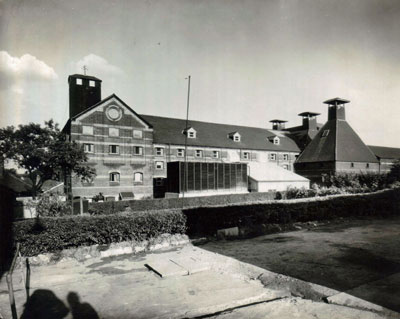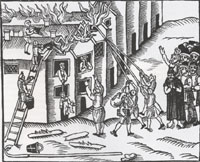
St Edmundsbury Fire
|
|
1608
|
There was a serious fire in Bury in 1608, and the old market hall was burnt down. The fire started between 8 and 9 am, on Monday, 10th April in Eastgate Street in the malt house of a Bury Maltster called James Randall. A malthouse might use fire in a special kiln to help dry the grain and then to promote germination. A negligent servant was blamed for letting things get out of hand, and the resulting blaze burned for 3 days spreading up Northgate Street, into Looms Lane, into the Market Place, possibly ending at Woolhall Street on one side and the Suffolk Hotel on the other. The Market Cross, built in 1583, and Toll House also burned down. This event proved the vulnerability of the old timber and thatch houses which still predominated in most towns in the land. Some 160 dwellings and 400 outhouses were destroyed, worth about £60,000.
The new corporation quickly added a new byelaw to the 132 passed in 1607. Thatch was prohibited as a roofing material in the town as it was blamed for allowing the wind to spread fire and "disperse itself into so many places". The modern legacy of this fire is that the east and centre of the historic grid pattern of the town no longer contains property older than 1608, whereas many properties to the west side still retain medieval structures hidden within them.
|
|
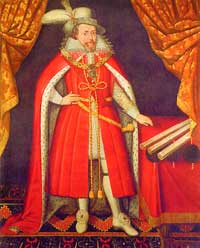
James I and three charters
|
|
1614
|
The town of Bury St Edmunds received a final Charter from James I which gave it the right to send 2 MPs to Parliament, and to hold a court of quarter sessions. The corporation were so pleased with their three charters that a painter called Fenn was commissioned to picture the king with a representation of the three documents, as shown here.
The latest writ also gave other new privileges to the town's council. The Court of Record was now extended from £50 a case to £200, and a Court Leet set up for dealing with items of good order such as weights and measures. There was also a new right to have a Coroner. Every retiring Alderman would be the Coroner for one year.
At last Bury had become a fully functioning self-governing borough with the powers it needed to run its own affairs. The justices also controlled malting and brewing and all leather buckets needed to be approved and registered.
|
|
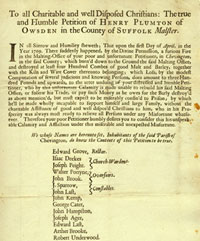 Henry Plumton's petition
Henry Plumton's petition
|
|
1709
|
Malting barley has been a local industry for centuries. It depends upon sprouting barley to generate natural sugars, but it must then be heated to prevent the growth process from consuming all the sugar. This heating has often resulted in fires breaking out within the maltings buildings. One such incident is shown here.
The illustration is of a printed petition of Henry Plumton of Ousden, Suffolk, although here it is spelled Owsden. He is requesting charitable assistance after a fire destroyed his maltings at Chevington and 'at least four hundred combes of good malt and barley'.
Plumton had lost not only his own business, but had also not paid for the barley which was destroyed. He estimated his loss at £300, and would be imprisoned if he could not raise the money. A list of locally prominent people attested to his loss in the petition.
|
|
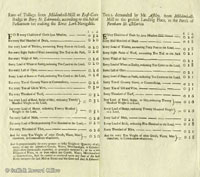 Ashley's tolls for using River Lark
Ashley's tolls for using River Lark
|
|
1716
|
The Lark navigation was now open for business from Mildenhall to Bury St Edmunds under an Act of Parliament passed in 1699/1700. By 1700 the River Lark was no longer navigable any further than Mildenhall from the sea, and so Henry Ashley obtained the Act to allow navigation as far as Eastgate Street. The Corporation of Bury were afraid of him setting up a wharfage monopoly, and opposed the plan. All Ashley could do was build his canal as far as Fornham, outside the Borough boundary.
Ashley's list of charges for moving loads along the new navigation are shown here. As usual, click on the thumbnail to enlarge it. He shows two lists on the page. One is for delivering the goods from Mildenhall Mill to Eastgate Bridge, "according to the Act of Parliament", and is on the left hand side of the page. The list on the right is for deliveries to "the present landing place in the parish of Fornham St Martin." Coal, timber, wool, salt and grain are at the head of the lists, possibly reflecting the expected traffic somewhat.
|
|
1765
|
In 1765, Joseph Maulkin, a maltster, acquired a large malthouse and granary on the Horsemarket, now called St Mary's Square. It stood on the corner where Westgate Street and Sparhawk Street met. A house went with the property,facing into the Horsemarket.
Next door, across Crown Street, stood Wright's Brewery. There had been a Brewery in Westgate Street, Bury St Edmunds, throughout the 18th Century, owned by three generations of the Wright family.
|
|
1773
|
In 1773 George Paul (1740-1828) and his wife came to Bury St Edmunds to set up as an ironmonger. The family originated from Burwell. Like many businessmen at the time, he was a religious dissenter, and they were welcomed into the close knit Independent Church. (Later this became the Congregational Church.) The church also acted as a banker in that church accounts recorded that £20 cash was lent to George Paul at 5% interest. George became a Deacon, as did his son, George Paul II (1776-1852) who preached throughout South West Suffolk, meeting all the leading corn growers and maltsters. Their descendants would leave Bury and, in 1877, found the firm of R & W Paul, the well known malting enterprise at Ipswich. The name Paul's Malt would survive into the 21st century, eventually renewing a presence in Bury St Edmunds.
|
|
1775
|
For much of the 18th century the popular drink was porter, a dark and heavy beer. The big London brewers wanted brown malt for the production of porter, which was best sourced from Hertfordshire and Essex maltsters. After 1800 public tastes favoured a lighter beer, and the pale malts required were best sourced from Norfolk and Suffolk.
|
|
1782
|
Joseph Maulkin, the prominent Bury maltster and businessman, died in 1782. He had joined the corporation in 1772, and was elected Alderman in 1778. He died leaving the large maltings on the Horsemarket, other town property, and a 175 acre farm at Bradfield st George. He left four sons, three of whom would become prominent in Bury affairs.
Joseph Maulkin, the eldest son,took over the properties. He would run the Maltings and the associated coal merchants business in Sparhawk Street. He would also run the Coaching service to London and Norwich out of the Six Bells on Chequers Square.
Thomas and Robert Maulkin were wholesale grocers and wine merchants on the Market Hill. Robert also founded the Suffolk Assurance Society.
The youngest son, Solomon managed the Six Bells on Chequers Square, probably also brewing his own beer on the premises. At this time the Six Bells was second only to the Angel for the hospitality trade. Today the site of this inn is covered by the Masonic Lodge.
|
|
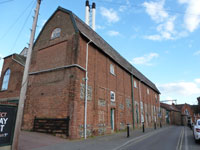
Wright's Brewery of 1789
|
|
1789
|
There had been a Brewery in Westgate Street, Bury St Edmunds, throughout the 18th Century, owned by three generations of the Wright family. This building seems to be part of the Westgate Brewery which dates back to the time of Matthias Wright. High up on the gable end overlooking the Fox carpark is a plaque which reads MW 1789, and probably indicates the date of building. Matthias was to be last of the Wrights to be a brewer as the entire premises and the brewing business was put up for sale by his executors in 1798.
Possibly because of the poor economic conditions around the threat of invasion by Napoleon it did not sell, and would stand idle until 1805, when the Buck and Greene partnership would take over, and begin to restart the brewing process.
|
|
1792
|
By Autumn of 1792, only a few months after opening, the Capital Brewery of Buckley and Garnish went bust. It was located between Guildhall Street and St Andrews Street, and had before 1790 been Oakes's Yarn Shops. The brand new brewery was sold for £2,500 on December 19th, which was reckoned to be £500 less than its value, to a Morris of Ampthill for his nephew John Clark. The sale included the Two Brewers in Westgate Street and the Unicorn in Eastgate Street.
It was to this brewery that Benjamin Greene would come, around 1800, to work for Clark.
It seems from his diaries that James Oakes considered going into brewing, but he was always cautious in business, and nothing came of it.
The Universal Directory of Britain was published in 1791, covering places in England and Wales. It was published by the patentees of the idea, at the British Directory Office, Ave Maria Lane, London. Volume II contains entries for Bury St Edmunds, and refers to events in 1792, and so must have been published no earlier than this year. It took five volumes in all to complete.
After listing the Gentry, the Clergy, the Physicians and the Lawyers, the Directory went on to Traders etc.. These were all listed alphabetically by surname, giving their trade, but no address was given. First listed was "Apsey Michael, (F.) Ironmonger", and "F" denoted a Freeman of the Borough. Six maltsters were listed. A few examples included the following:
- Apsey Michael, (F.) Ironmonger
- Cook, John (F) Maltster
- Carss, Robert (F) Banker
- Chaplin Thomas and William, Watchmakers
- Deck Philip, Postmaster
- Hailstone, James, Maltster
- Hunt John, Walking Post
- Jaques Robert (F) Maltster
- Leech, Henry (F) Maltster
- Lumley and Gudgeon, Watchmakers
- Middleditch James, Maltster
- Oakes James (F) Yarn Maker
- Oliver Laver, (F) Auctioneer
- Pearsall, Thomas (F) Gunsmith
- Parker, Benjamin (F) Gunsmith
- Paul George, Ironmonger
- Rogers Robert, (F) Silversmith
- Roberts John, Watchmaker
- Spink John (F) & Carss, Bankers
- Steward, Henry, Maltster
- Singleton Thomas (F) Stonecutter
- Thomson John (F) Silversmith
- Tilbrook John (F) Silversmith
- Tickell John Nathan, Gunsmith
- Warren Thomas, Parish Clerk
|
|
1798
|
There had been a Brewery in Westgate Street, Bury St Edmunds, throughout the 18th Century, owned by three generations of the Wright family. In the universal Directory for 1791 Matthias Wright had been described as Assistant Justice. In 1798 Matthias Wright's executors had decided to sell the Westgate Brewery, together with its Malting House in Southgate Street and various Public Houses. Possibly because of the poor economic conditions around the threat of invasion by Napoleon it did not sell, and would stand idle until 1805, when the Buck and Greene partnership would take over, and begin to restart the brewing process.
|
|
1799
|
Having given up the yarn trade four years earlier, in 1799 James Oakes sold his comb shops to John Clark, a brewer, for £900. He had sold his Stowmarket property a year earlier. Most of the other big Bury yarn makers had also given up by now.
In 1792 John Clark had taken over the Capital Brewery in St Andrews Street which was next door neighbour to Oakes's now redundant comb shops. In order to expand his brewery he needed more space, and he probably needed more staff. Either in 1799 or some time in the next two years he would engage Benjamin Greene from Bedford as an assistant brewer on a three year contract. Greene would go on to found the firm which eventually became Greene King, but this seems to be the only tenuous link that the firm of Greene King can have with 1799.
|
|
1800
|
The old taste for heavy porter was being replaced by a demand for a lighter beer. The light well drained soils of the Brecklands and sandlings produced the short plump thin-skinned barley which produced the best quality malt which now became in demand by brewers.
The malt duty returns show that Suffolk was the county making the most bushels of malt in 1801/1802.
|
|
1801
|
In 1801 Bury was the second town in the county of Suffolk, having a population of 7,655, according to the census. However, some have said that this census figure was probably some five percent underestimated. Bury was run by a closed corporation of 37 members who returned two MP's to Parliament. It was the venue for the county assizes and quarter sessions, as well as petty sessions and other Borough courts, such as the Coroner's court and the court of pie powder, which enforced market bye laws. There were various industries supplying local needs, but the big earners were brewing and malting. The great fortunes made in the last century from yarn making were still mostly intact, although the yarn industry itself was over. It was a prosperous and well situated town, widely known for its social life. Every October, the Bury Fair was nationally known for its social entertainments.
|
|
1805
|
In 1805 we can trace the real beginnings of the brewers Greene, King and Company, when Benjamin Greene set up a partnership with William Buck to brew and sell beer. Greene had been apprenticed to Whitbread's Brewery in London, in the 1790's and apparently when this was over, he moved to Bury somewhere between 1799 and 1802. He seems to have entered into a 3 year contract as Assistant Brewer at the Capital Brewery of John Clark in St Andrews Street. After this he decided to set up on his own account.
William Buck had been a yarn manufacturer in Bury, like James Oakes, and this business was now moribund. Buck lived in Westgate street opposite to Guildhall Street at number 24, and his yarn works had been nearby. His combing shop and warehouse was turned into a tenement of six houses in 1803 and 1804. Whereas Oakes turned to banking, Buck now turned to brewing. Buck provided capital, business knowledge and a strong local reputation, while Greene provided the brewing know how. Both men were non-conformists, attending the Independent Chapel in Whiting Street. Buck was 60 at the time and it seems that managing the brewery fell mostly to Greene.
There had been a Brewery in Westgate Street, Bury St Edmunds, throughout the 18th Century, owned by three generations of the Wright family. In 1798 Matthias Wright had decided to sell the Westgate Brewery, together with its Malting House and Public Houses. It did not sell, and for several years had stood empty. Finally in the Winter of 1805, The Buck and Greene partnership took it over, and began slowly to restart the brewing process.
|
|
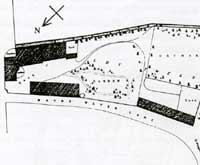
Location of Braddock's Brewery
|
|
1821
|
The last few wool combers and spinners had finally given up in Bury by now. The town's only industry would be brewing and malting until Robert Boby's engineering works opened in mid century.
In 1821 there were three large breweries in Bury, by the standards of the time. These were breweries which made beer to sell, not only to the public, but to other public houses and inns for resale. These were called Common Brewers, as opposed to the many inns and large houses, where beer was brewed for consumption on the premises. These Common Brewers were as follows:-
- The Brewery of Stutter and Gallant in Guildhall Street (previously the Capital Brewery)
- Buck and Greene's Westgate Brewery
- Henry Braddock's Southgate Brewery
Stutter and Gallant had taken over the Capital Brewery of John Clark. It was started in 1791 by Buckley and Garnish, who went bust in 1792, when it was bought for John Clark. It extended from Guildhall Street through to St Andrews Street. In 1821 it was probably the largest Brewery in Bury, although none of them were very large at this time.
Braddock's brewery was across Southgate Street from his maltings, at the foot of Maynewater Lane.
|
|
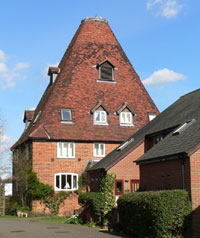
Braddock's Maltings
|
|
blank |
All these brewers also had their own maltings, usually adjacent to the brewery. Stutter's was near his brewery but facing St Andrews Street, Braddock's was just behind his White Hart inn on Southgate Street. They would also buy in malt from other maltsters.
One of the biggest of the independent maltsters was Maulkins, which was in St Mary's Square, not far from the Westgate brewery. Several local inns would buy in malt and brew their own beer for sale on and off the premises, a practice which would continue for many years yet.
|
|
1827
|
In 1827, Joseph Maulkin, the prominent Bury Maltster of the Horsemarket, died without any sons. His father, also called Joseph, had acquired the 1.5 acre site with its house, granary, and maltings, between Crown Street and what we now call St Mary's Square, in 1765. Much of this property, as well as others, now passed to Robert Maulkin, who was the son of Solomon Maulkin, Joseph II's youngest brother. The property included 4 public houses in Bury, two more in the country, 38 acres in Bury and 200 more elsewhere in Suffolk. Robert would not be so successful as his uncle had been, and shortly after 1836 he was persuaded to be "retired off" to Brinkley Grove.
|
|
1828
|
Robert Maulkin, who was now running the Maulkin family maltings and other businesses, bought more inns. The business already had 4 in Bury and 2 in the country. In 1828 he bought the Castle, and the adjoining Moyse's Hall. In 1831 he would buy two more inns, but the mortgage payments on all these would prove too much for the business to bear.
|
|
1829
|
Stutter and Gallant's brewery on Guildhall Street, their maltings nearby in St Andrews Street, and 11 country inns, were sold. It was opened as the Capital Brewery in 1791 by Buckley and Garnish, who went bust in 1792 when it passed to John Clark. By the 1820's it was Bury's largest brewery, but there was strong competition from both Greene's Westgate Brewery and Braddock's Southgate Brewery. The brewery seems to have closed until 1837, when John Everard started it up again.
|
|
1830
|
William IV became King. A major cholera outbreak began in Britain and continued into 1831. It took ten years for the link to insanitary drinking water to be accepted.
By 1830, the so called Gin Palaces were such places of drunkenness and ill repute, that an attempt was made to curb gin drinking by encouraging beer drinking. Government took the tax off beer. Beer was at this time very much an everyday drink - even children drank so called small beer - and it was seen by those among the evangelical and temperance movements as very much a secondary evil.
Farmers were also keen on beer production as it required malt from their barley in its production. Brewers and Hop growers would also expect to benefit from an increase in beer drinking.
So the Duke of Wellington's government brought in the Beerhouse Act in 1830. The idea was to allow householders to set up beerhouses at home for the sale of beer or cider, merely by paying a two guinea fee. The duty of nine shillings and two pence on a barrel of beer was abolished as an encouragement. Greenes brewery was reckoned to have increased its output by 50% in the year after the new Act.
Before 1830, all inns had to provide accommodation, refreshments and stabling for travellers by law. The Beerhouse Act removed this obligation. It was possible for a family to start a beerhouse in their front room, entirely within the law. Not surprisingly this put a great pressure of competition on the old coaching inns, which tended to decline.
In Bury a meeting of innkeepers was called to discuss the new Act in the Three Kings inn, which stood in the Cornhill, near the Market Cross. Perhaps aware of the consequences of the Act, and being little that could be done about it, only 13 Bury Innkeepers turned up. The Three Kings became a branch of Montague Burton's Tailors in 1933.
Over the next few years many new beerhouses started in Bury such as the Spread Eagle in Out Westgate in 1831, the Butchers Arms in Field Lane (Kings Road) in 1839, the Dove in Hospital Road, also in the late 1830's, the Black Girl in Guildhall Street in 1836, set up cheekily next door to the Black Boy, the Jolly Wagoners in Cotton Lane in the 1830's, and so on. Beerhouses continued to be set up freely until controls returned in 1869.
In 1830 Pigot's published their first Directory of Suffolk. This listed each town in the County, describing their history, local gentry and professions, and their tradesmen. Bury is described as "on the western bank of the river Bourne or Larke."
Tellingly, it says, "The corporation, who are self-elected...."
Unlike the 1791 Universal Directory, tradesmen were listed by category, so that all Bankers, for example, were listed together. In addition the address of each person was included. House numbers were included and this must have been one of the first occasions on which this was possible. Numbering was just starting to be adopted as national practice. Larger cities had used numbering since the 1790s.
The Maltsters recorded in Pigot's Directory were
- Henry Braddock Southgate Street
- Samuel Cooper malted at 16 Long Brackland
- William Fenton at Southgate Street,
- Benjamin Greene 1 Westgate Street
- Robert Johnson 54 Guildhall Street
- Thomas Harmer jun. at 70 Westgate Street
- James R Harvey, 59 Churchgate Street
- E E Leece at Long Brackland
- Robert Maulkin at 10 St Mary's Square.
- Elizabeth Lucy Steel was at 64 Guildhall Street
- John Steele at 9 Risbygate Street
Brewers recorded were as follows:
- Braddock, Henry, Southgate Street
- Greene, Benjamin, 1 Westgate Street
|
|
1831
|
At this time the typical malthouse was a small operation, steeping between 25 and 35 quarters at a session. However, there remained many one-man houses steeping only 10 to 15 quarters, where one man handled the whole process of barley reception, malting and despatching the finished malt.
The malting season was up to 8 months a year, as summer temperatures made the process impossible to control. An efficient maltster was making three steeps a fortnight.
A quarter of barley was 448 pounds in weight, or 4 hundredweight, (cwts) and 5 quarters of barley made one ton.
A malthouse recently built in Ipswich in 1836 for a 20 quarter steep was advertised with a working floor of 3,000 square feet, (150 feet by 20 feet) and a plate kiln. Thes houses were usually only on one floor. It would be another thirty years before malthouses with two or three floors became common.
The importance of malt to the brewer is seen in the fact that for most of the 19th century malt accounted for 65% of the cost of beer production. This helps to explain why brewers would try to produce their own malt if possible. Brewers would become the main competitors to the sales-maltsters. Alternatively the brewer might in the long term come to have a rolling contract with a maltster that he trusted to produce good quality malt, or commission deliveries from trusted suppliers.
|
|
1833
|
In 1833 Richard Payne made a survey of Bury, called "Particulars of the Lands in Bury St Edmunds". A new map was needed as Lenny's map of 1823 was already out of date. Payne's survey recorded a growing town, just about to expand dramatically beyond its ancient boundaries. His map would be published and printed in 1834.
The River Lark was navigable to this point and there was a large Maltings just along the Fornham Road, so customers for the Tollgate Inn nearby were not lacking despite its out of town location.
Payne recorded a dozen maltsters in Bury. Two of the largest were Henry McL'Roth and Robert Maulkin. They owned 11 public houses between them, and 12 others were owner occupied. Maulkin was the largest maltster in the town owning six town pubs and two more in the surrounding countryside.
The brewers Greene and Braddock only owned 3 between them. Bury had 54 inns and public houses, and at this time only 20 of them did not brew their own beer on the premises.
However these operations, although locally large and important, were out produced by Patrick Stead of Beccles, Yarmouth and Halesworth in East Suffolk. Stead produced malt for Trumans, and in 1846 he claimed to be "almost the largest" maltster in the country.
|
|
1836
|
In December 1836, the Bury Maltster, Robert Maulkin had to sell the contents of his house on St Mary's Square to raise cash to pay off some of his mortgages and other debts. In 1834 the family had felt they needed to set up a trust to ensure the financial survival of his wife and family, safe from creditors. Robert was persuaded to go off and live out of harm's way at Brinkley Grove, and take on George Beeton to run the Malting business as a partner.
|
|
1837
|
The old brewery of Stutter and Gallant in Guildhall Street had closed in 1829. It was now reopened by Henry Everard.
|
|
1839
|
In 1839 Pigot and Co published Pigot's Directory of Suffolk. Such directories aimed to give a detailed history of each town, together with lists of the main streets, nobility clergy and gentlemen as well as traders, and their addresses.
Three brewers were listed. These were
- Henry Braddock of 80 Southgate Street
- Edward Greene of Westgate Street
- Henry Everard in Westgate Street
Greene and Braddock were also listed as Maltsters, along with 10 others.
The Maltsters were
- Henry Braddock malting at 80 Southgate Street
- William Fenton at Southgate Street,
- John Clarke at number 74 Risbygate Street,
- John Steele at 9 Risbygate Street
- Robert Clarke at 2 Meat Market
- Samuel Cooper malted at 26 Long Brackland
- Edward Eugene Lease at 184 Long Brackland
- Edward Greene was in Westgate Street
- Thomas Harmer at 70 and a half Westgate Street
- George Beeton at 10 St Mary's Square.
- Thomas Moore MacLeroth was at 64 Guildhall Street, and
- Humphrey Steggles at 51 Churchgate Street.
|
|
1841
|
By 1841 a large brewery and maltings existed in Haverhill along both sides of Camps Road. It was owned by James Boreham to serve his pubs and to sell to others. Before such breweries, all beer was brewed by individual publicans on their own premises.
|
|
1844
|
In 1844 William White published his "History, Gazetteer and Directory of Suffolk".
White's Directory recorded four brewers in Bury St Edmunds. These were
- Henry Braddock of 107 Southgate Street
- John Clarke of 74 Risbygate Street
- Edward Greene of Westgate Street
- James Waldwine of 28 St Johns Street
|
|
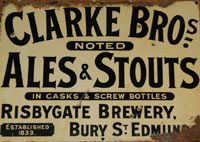
Clarke Brothers, est 1833 |
|
blank |
Apparently Clarke's Brewery was set up in Risbygate Street in the early 1840's, as it was not recorded as such in the Pigot's Directory of 1839. He was, however, recorded there as a Maltster at 74 Risbygate Street.
Moreover, there is a sign in Moyse's Hall museum from a much later period which claimed "Clarke Brothers noted ales and stouts, Risbygate Brewery, Bury St Edmunds, Established 1833." A better example of this sign is illustrated here, and in 2008 could be seen in the Three Kings public house at Fornham All Saints. Whatever the exact date of the brewery, Clarke had definitely taken over over the existing Malthouse at 74 Risbygate Street by the time of the 1839 Directory. This old Malthouse survived in various uses until 1980, when it stood derelict for 20 years. In 2005 it was taken over by St Matthew Housing Association, and converted eventually into homes and a Heritage Centre, opening in 2007.
Clarke's brewery continued up to 1917, when Harry Clarke would sell out to Greene King. After 1887 Clarke's would be the only remaining serious competitor to Greene King in Bury.
There were 12 people listed as Maltsters, including the best known names, Braddock, Clarke, Greene and Maulkin.
The Maltsters were:-
- Henry Braddock malting at 107 Southgate Street
- William Fenton at 71 Southgate Street, and
- Ann Goldin at 110 Southgate Street.
- John Clarke was at number 74 Risbygate Street
- John Hayward Guy at 12 Risbygate Street and
- James Lee at 27 Risbygate Street.
- Isaac Cooper malted at 17 St Johns Street, and
- Edward E Lease at 53 St Johns Street.
- Edward Greene was in Westgate Street, with
- Robert Maulkin nearby at 10 St Mary's Square.
- Hannah MacLeroth was at 64 Guildhall Street, and
- Humphrey Steggles at 51 Churchgate Street.
It may be noted that the 1839 directory gave Cooper's address as 26 Long Brackland, and Lease's address as 184 Long Brackland. In reality they had not moved. In 1842 Long Brackland was renamed St Johns Street, and subsequently re-numbered.
|
|
1845
|
By 1845 it was nine years since Edward Greene had bought Westgate Brewery from his father, Benjamin Greene. He had agreed to pay his father over a nine year period, and the loan was now paid off. Edward would now have the money to expand the brewery as he wished. He was well aware that the railway was coming to Bury, and anticipated a great new market for his beer, opened up by fast, relatively smooth travelling conditions.
In 1845 Edward Greene built a new and extensive Maltings in Bridewell Lane. He had already been renting other maltings in Bury, but this new one outstripped them all. It was the first increase in area that the brewery had received since Buck and Greene began in 1805. These maltings, known as School Maltings, continued in use until 2003/04 when they were converted into housing. The ground was bought from the Guildhall Feoffees, adjacent to their school.
Greene also reorganised his brewery to increase production capacity, and sold off 30 hogsheads and other brewing equipment which he had replaced.
|
|
1848
|
The Golden Fleece stood in Churchgate Street, on the corner of College Street. It had been there since 1737, and in the rear of the pub stood a Brewhouse. It had probably been making beer for itself for many years, as had been the custom for most large old inns. It is notable because, like the Cannon Brewery, it brewed its own beer right up to 1913 or 1914. These two independent brewers were the last two establishments to survive brewing their own beer up to the time of the Great War.
|
|
1851
|
Edward Greene, the Brewer at the Westgate Brewery was recorded as employing 18 men and 3 boys at these premises. This number would increase greatly in the next decade.
|
|
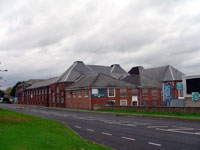
Dunnell's Maltings of 1851 |
|
blank |
The coming of the railways would have a profound effect upon the commerce of the River Lark. This navigable river extended from the Great Ouse river, through Mildenhall and upstream as far as the Fornham Wharf. This wharf was within the parish of Fornham All Saints, upon land owned at the time by Sir Thomas Gery Cullum.
Much of the land at the Fornham Wharf had been coalyards, and most of the tonnage on the river had been coal. The Ipswich to Bury railway line had been delivering coal right into Bury St Edmunds at Northgate Street since December 1846. Thomas Ridley had rented a coal warehouse from Sir Thomas at Fornham Wharf, but he no longer required its use. Sir Thomas probably did not have the money, or the inclination, to redevelop the site himself, so he let it to Robert and John Dunnell, who built a large new Malt House on the site.
This is what the White's Directory of Suffolk for 1855 said about it.;
"Sir T R Gage, Bart, is lord of the manor (of Fornham All Saints), but part of the soil belongs to Sir T G Cullum, Bart, on whose estate, at the south-west angle of the parish,1 mile N. of Bury, is a commodious Wharf, at the termination of the Lark Navigation, ... and a large Malting House, built in 1851."
The Directory for this parish failed to identify a maltster
|
|
1854
|
By 1854 Edward Greene was making good returns from his Westgate Brewery. He had been living in his childhood home, the old house off Crown Street since 1840, but now moved into his father's grand house at 6 Westgate Street, adjacent to the Theatre Royal. The house in Crown Street which had once been the retirement home of John Reeve, the last Abbot of Bury, was finally demolished. The site was used over the next two years to extend the brewery and has now completely disappeared under brewery works.
Across Bridewell Lane Greene also built the Foundry Maltings, facing Westgate Street, but next to the School maltings.
Edward Greene also now extended his business into farming. He leased Stone Bridge Farm in Bury from Lady Cullum of Hardwick, for a twelve year term. At first its 138 acres provided extra fodder for the brewery horses, but it became more integrated into the business. The farm could provide some malting barley, as well as fodder, and spent grains from the brewery could in turn go to feed the animals. The labour could also be shared between brewhouse and farm.
|
|
1855
|
In 1855, Robert Boby began to manufacture corn dressing machines.
Initially Boby seems to have made use of the yard behind his iron monger's shop in the Meat Market to produce his new machines. But he may well soon have been renting space in the defunct Home Maltings in St Andrews Street for some time before he finally purchased it. He did not risk buying further property until 1860.
|
|
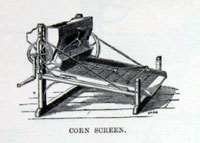
Silver Medal Corn Screen |
| 1860 |
Boby's Patent Corn Screen successfully competed at Norwich, in 1860, against a new patent self-cleaning and adjustable rotary screen, and obtained the silver medal. It was described as follows in its 1862 London Exhibition Catalogue for Class IX.
"BODY'S PATENT CORN SCREEN effectually separates all thin corns, stones, seeds, etc. from either barley, wheat, or sanfoin, and produces a sample that enables the merchant or farmer to obtain the highest market price for his corn. "
Whether Boby had initially aimed his corn screen at maltsters is debateable, but very quickly he discovered that this could become a lucrative market. His advertising now spoke to maltsters directly.
"To maltsters it is invaluable, as the duty on malt renders it necessary they should pay only on the best barley.
- Screen No. 2, 50 bushels per hour. £7-0-0
- Screen No. 1, 90 bushels per hour. £9-0-0
- Stone separator, extra. £1-10-0
- Screen No. 3, 150 bushels per hour. £15-15-0 "
Gradually Robert Boby would come to make many different items specifically for the malting trade.
No doubt his connections to the local brewer, Edward Greene, produced many ideas in this direction.
On 31st August 1860, the creditors of James Garrod sold the Home Maltings to Robert Boby. Home Maltings had been part of the premises of the Capital Brewery (Buckley and Garnish) which had opened in 1791 and closed a year later, passing to John Clark. It then became owned by Stutter and Gallant, (1813 to 1844) and then to James Garrod, a common carrier. Garrod got into financial difficulties and the Trustees for his creditors arranged the sale. Boby paid £900, and it is interesting to note that there were three current occupiers listed in the deed, being Grayston, Burrell and Boby himself.
|
|
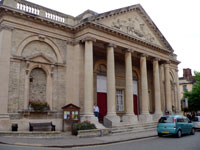
New Corn Exchange
|
|
1862
|
The present corn exchange was completed at the top of Abbeygate Street. The north side of the building replaced the Shambles, a row of open colonnades, where butchers would hang carcasses for evisceration and preparation. The name Shambles is still used for the short stretch joining the Traverse to Cornhill. Part of the old shambles building was incorporated into the Corn Exchange, as it was a fine Georgian construction.
The new Corn Exchange would be used for corn sales on Wednesdays up to 1997. On other days it would be used for public functions. It cost the sum of £7,000. It was the third purpose built Exchange used in Bury, the first being in the Market Cross. The corn exchange now being replaced, which was the second, was in the building between the Market Cross and the new Corn Exchange.
In 1862 Lord Manners sold Fornham Park and the Fornham St Genevieve estate for £85,000 to William Gilstrap, who, in 1868, would also buy about one third of the parish of Fornham All Saints. Sir William Gilstrap (1816-1896), was a native of Newark upon Trent, in Nottinghamshire, and was a well known benefactor of that town. He had made his fortune in the malting industry, and he wanted the Park in Fornham St Genevieve for its sporting value. He does not seem to have had any involvement with any maltings in Suffolk.
The yield from taxes on beer and malt were was one of the main stays of the public finances. In 1862 William Ford wrote that "Since the reign of Queen Elizabeth ......no trade or industry has laboured under so vast a complication of oppressions from fiscal regulations and other disadvantageous circumstances as the malt Trade."
|
|
1863
|
In 1863 it appears that George Boby took up a partnership with C J Tozer of the Bury St Edmunds firm of Cooper, Tozer and Co to begin a career as a coal and seed merchant and maltster. He had been a grocer and draper in Stowmarket while his brother, Robert Boby had moved from ironmongery into the manufacture of agricultural machinery, but specialising in malt screens for the malting trade.
In 1865 he would move from Stowmarket permanently to St Andrews Castle in St Andrews Street, South.
|
|
1866
|
In October, Edward Greene, the brewer, gave a celebratory dinner in the Theatre Royal for 350 of his workmen and those of Robert Boby and George Cornish, the Bury Engineers. It celebrated another expansion of his Westgate Brewery. He had added a second steam engine to the brewery, a ten horsepower machine built by George Cornish. Cornish did Greene's engineering work from 1850 to 1880, while Boby's supplied malt screens and made other malting equipment and agricultural devices. All the work had been undertaken by firms in Bury, a source of pride for Greene, who had been elected as one of the town's two MP's a year earlier.
This celebratory event marked a great revival in Bury as a manufacturing town, and a new prosperity for the workers of the town. Both pub and home brewing were being rapidly replaced by brewing on an industrial scale, and with the new foundries, gave alternative job opportunities to the agricultural worker looking for a new start.
|
|
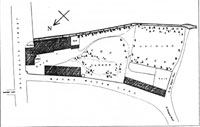
Braddock's Southgate Brewery
|
|
1868
|
In March 1868 Henry Braddock, one of the old brewers of Bury, died. He had owned the Southgate Brewery in Southgate Street, along with his White Hart Maltings and eleven inns. One of these inns, the White Hart, was situated just across the road from the brewery, as was the White Hart maltings. Braddock was an old man who had no sons, although he had been prominent in Bury affairs for years. His politics were of the old-fashioned Whig variety, and his brewery was similarly old-fashioned. These premises were now put up for sale by Braddock's executors. Fred King, who had married into the Maulkin Malting dynasty, and now ran the Maulkin business in St Mary's Square, announced in the Bury and Norwich Post newspaper, on June 16th, that he intended to take up the Brewing business. He wrote that he had entered into partnership for the venture with Francis Phillips, late of the Stowmarket Brewery, and that he was looking for premises.
Edward Greene, knowing King's energy and drive, felt he needed to act to protect his own brewing business. Braddock's old brewery was still on the market. In August, 1868, in order to prevent King from acquiring Braddock's Brewery, Greene bought Braddock's house, brewery, inns and other holdings for £7,000. The Southgate Brewery was old and unmodernised, and Greene now closed it down. Greene kept the maltings and used it right up to the 1930's. He also sold off seven of the pubs to recoup some of his outlay. None of this, however, deterred King from his ambitions.
|
|
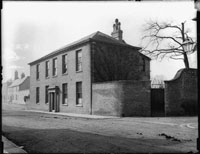
Braddock's/Pead's House
|
|
blank |
William Greene ensured that Braddock's Brewery stayed closed by the simple expedient of selling the brewery and house to his own Brewery Manager, William Pead. Pead had joined Greene's brewery from school in the 1840s, and after 20 years had been appointed Brewers Manager, and was receiving a share of the profits of the maltings. William Pead would reside here from 1869 until his death in 1903, having become Company Secretary and a shareholder in the business.
|
|
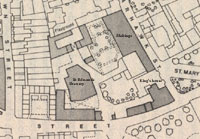
St Edmunds Brewery by 1890
|
|
blank |
In July, 1868, Fred King bought the Maulkin's Maltings and other property in St Mary's Square from his father in law, Robert Maulkin, for £5,300 using a mortgage from the Maulkin Family Trust. The maltings were very old and unmodernised, so a site was cleared on the corner of Westgate Street for an up to date "tower" brewery.
Fred King was aged 40 in 1868, when he built the brand new St Edmunds Brewery in Sparhawk Street, towering over Greene's Brewery only a few yards away in Westgate Street, Bury St Edmunds. It started producing beer at Easter, 1869, and they were acknowledged to be very good beers. King's stout was especially good.
The Maulkins also owned 6 pubs in town, like the Ram in Eastgate Street, giving a ready made outlet for King's beer. King was a shrewd man with 11 children to support, and began to buy up more pubs after 1870. He became stiff competition for Greene's business.
|
|
1869
|
Regulations came into effect in 1869 whereby beerhouses came under the control of local magistrates. Set up under an Act of 1830, these had spread because of the ease of setting one up, even in a seperate room in a private house. Tighter controls now meant that beerhouses gradually declined, or were improved to the status of Alehouses or Public Houses. Many were bought up by breweries.
Just before the new controls came into force the Britannia Inn was built in Ipswich Street. This was a purpose built beerhouse, wrapped around the corner of Ipswich Street and Long Brackland.
The Falcon also opened in Risbygate Street, but applied for, and obtained, a full license. Much new housing was being built in this area. It was at the end of a row of houses called Paradise Place. This was an edge of town inn at this time, and had room for excellent stabling.
|
|
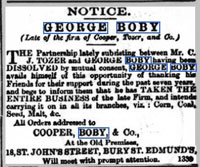
Cooper Boby Maltsters |
|
1870
|
In July 1870, George Boby and C J Tozer dissolved their partnership. The old corn, coal and seed merchant and maltsters firm of Cooper, Tozer and Co now became Cooper, Boby, and Co. at their old address of 18 St Johns Street. C J Tozer would also continue on his own as C J Tozer of 53 Garland Street. This advertisement also gives the information that George Boby had been in this business in Bury for the last seven years.
After 1870 the pattern of the brewing business in Bury St Edmunds changed dramatically. The various new controls on licensed premises brought in in 1869, stopped the free trade in licenses. Brewers needed some way to tie in their customers in the new restricted market. Elsewhere in England this did not really have much effect until around 1880, but in Bury, Greene's brewery had a dangerous new competitor in Fred King's St Edmunds Brewery, which had been producing beer for just a year, but was being well received by the public.
From 1870 to 1880 Fred King bought 40 inns, pubs, and beerhouses, and tied them all to buying his beer.
Edward Greene had always preached the virtues of Free Trade, and in the past had always sold off any pubs that he had acquired. Now he saw that conditions had changed, and over the next ten years he also acquired 44 new pubs, the first being the Dog and Partridge, next to his brewery yard. With his own time being short, and his son Walter spending most of his time hunting to hounds, Edward also brought his nephew, Edward Lake into the firm in 1869. Lake was to prove a most valuable addition in the next few years, becoming a partner by 1876.
Jesse Gough was born in Gawcott, Buckinghamshire on 16th June 1832. He married his wife Elizabeth Salmon in 1855. They left for Australia in May 1855, where Jesse worked in a store and made friends with a Charles Smith. They then started up a maltings business in Melbourne.
Jesse sold his part of the Melbourne maltings to a Thomas Burston in late 1869. This Thomas Burston (who traded under his father's name of Sam Burston), and Charles Smith went into partnership with a Mr Mitchell. They opened a new maltings in Melbourne which is still going strong today.
When Jesse Gough returned to England it is probable that the maltings that he opened in Bury was part funded by the Australian company, but the English firm traded as Gough and Co.. He remained in partnership with Charles Smith of Melbourne, Australia, until 1879, when that partnership was formally dissolved.
In 1870 Jesse Gough also acquired a large site on Thingoe Hill, behind the railway station. The 1880s OS survey map shows two malthouses on this site. These appear to be part of Gough's purchase at this time. Presumably these old malthouses were destined to be replaced by a more modern house to be designed by Mr A Grimwood for Jesse Gough.
By 1884 any existing buildings on the site were replaced by a large new complex known as Old House Maltings, but in later years were always known as Gough's Maltings. By the 1960s this had developed into the largest surviving operating traditional floor maltings in the UK.
|
|
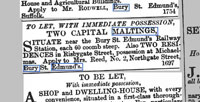
Two Maltings for sale |
|
1871
|
In the census for April, 1871, Jesse Gough was recorded as a maltster and had 12 employees.
In September, 1871, the Bury Free Press carried this advertisement for the sale of two 60 comb steep maltings near the railway station.
|
|
1872
|
S Tymms produced a new edition of "A Handbook of Bury St Edmunds." There were numerous maltings in Bury, and the two breweries in Westgate Street, Greene's Westgate Brewery and Fred King's St Edmunds Brewery. Neither brewery employed many men. Boby's agricultural implements works in St Andrews Street employed 200 men by contrast.
|
|

Dunnell's Maltings of 1851 |
|
1874
|
In 1874 Jesse Gough bought the lease of Dunnell's maltings on the Mildenhall Road, which at the time was within Fornham All Saints parish. At the same time he leased the Priory, only a short distance away.
Gough would go on to own several maltings around East Anglia. He had a maltings in Long Melford, now apartments; one in East Harling, now a tarmac company; one in Bures St Mary, believed demolished; one in Stonham Aspell, now demolished, one in Felixstowe, near the docks; and one in Stowmarket, now a nightclub.
|
|
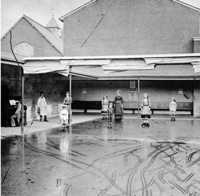
Mr Robinson's skating rink |
|
1876
|
According to the BSE Past and Present Society website, Mr T B Robinson opened his skating rink in the grounds of his residence, Brooke House, Westgate Street on Easter Monday, 17th April 1876. The rink was 92 feet by 36 feet laid on concrete covered with Spanish asphalt, to provide a surface like ice. The south side and centre were open to the elements but the other sides were under cover. There was a practice room, called a 'Nursery', where clients could be taught how to roller-skate. One of the maltings of Greene King in Westgate Street was known as the Rink Maltings in 1880.
|
|
1877
|
In 1877 R & W Paul established their first substantial maltings in Ipswich. The Pauls were strongly Independent in religion and were part of the close knit dissenting community in and around Ipswich. These contacts often produced marriages and business associates, helping the brothers to build up Paul's into a substantial and long lasting business.
|
|
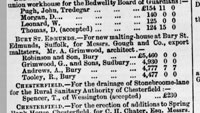
Tenders for Goughs Maltings |
|
1878
|
In Building News, 19th April, 1878, this list of tenders for a new malting house for Gough and Co was published. The architect was A Grimwood and the lowest tender was by R Tooley of Bury St Edmunds, in the sum of £4,477.
In September, 1878, George Boby accepted his son, Charles George Boby into his firm, now renamed George Boby and Son. The oldest son entered the malting and seed merchant side of the business, and the second son entered the finings business at the Station Works.
|
|
1879
|
White's issued a new Directory of Suffolk in 1879. By now these Directories were very well developed.
The Brewers listed were as follows:-
- Bishop, RA and C of 65 Guildhall Street, (at the Saracens Head)
- Clarke, John, of 62 Risbygate Street
- Greene E and Son, of Westgate Brewery
- King Frederick W, Westgate Street
- Lock Alfred, 92 St Johns Street
- Phillips Brothers Northgate Street; and Stowmarket
Maltsters listed were:-
- Clarke, John, of 62 Risbygate Street
- Cooper, Boby and Co, Railway Depot; and Stowmarket
- Gough Jesse & co, Out Northgate
- Newson P H 71 Risbygate Street
- Prentice Thomas, Town Hall, Meat Market
- Wing Charles of 10 St Andrew Street North; and Hawstead
|
|
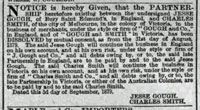
Gough and Smith's partnership dissolved
|
|
blank |
Jesse Gough had continued in partnership with Charles Smith of Melbourne, Australia, until Jesse had been in Suffolk for nine years. This partnership was relinquished on 31st August 1879, as can be seen in the attached newspaper notice in the London Standard, dated 9th September 1879. In England the original company style of "Gough and Co" would now become "J Gough & Co". In Australia the existing company of "Gough and Smith" would now become "Charles Smith and Co".
At some point Jesse Gough entered into partnership with George Boby who ran the Boby Brothers works on Station Hill, and has also been described as a "large maltster and corn and seed merchant of the town". George Boby's corn and seed business was at 17 St Johns Street, and his Cooper, Boby & Co maltings were nearby.
|
|
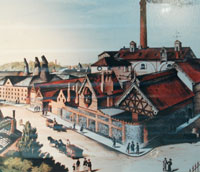
Greene's Westgate Brewery
|
|
1880
|
In Westgate Street Edward Greene built the Rink Maltings on the corner of College Street. An article in the Bury and Norwich Post of March 4th, 1884, tells us,
"The Rink malting, erected by L Jackaman from designs by Mr H F Bacon, architect, of Bury, has been only recently constructed on the site of the old Skating Rink." By 1884, the Westgate Brewery had six maltings, all producing different malts to suit the different beers produced at the time. The Westgate Brewery now looked as it does in this picture, which is in the Greene King Museum. The Rink Maltings of 1880 is visible on College Street, with the 1855 malt house beyond it. The garden of Fred King's house and brewery premises on St Mary's Square is visible in the bottom right hand corner.
In October 1880 the Malt Tax was abolished. This was a watershed in the history of the Malting industry.
One result of this tax had been on the technology that could be used. For example the steeping cisterns previously had to be built flat bottomed, only 40 inches deep, and with 48 inches above it. This constrained its usage to be a manual operation requiring much labour. After 1880 steeping cisterns could be built with hopper bottoms which enabled gravity assisted emptying and thus could be on upper floors.
Patent kilns also came into use after this date. There were three main producers of patent kilns, one of which was Robert Boby of Bury St Edmunds. Two competitors were Robert Free of Mistley and H J H King of Nailsworth in Gloucestershire.
|
|
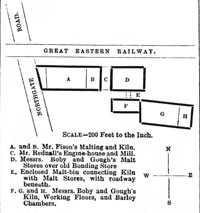
Maltings Fire Northgate Street
|
|
1881
|
Andrew Gough has pointed out to me this report of a catastrophic fire at Gough and Boby's maltings in Northgate Street, on Friday 9th December, 1881 at about 7 pm. The report comes from the Bury and Norwich Post and Suffolk Herald dated December 13th 1881. Luckily the newspaper felt that it needed to publish a diagram to explain the locations of the premises in question. This helps us to understand the locations of Gough's business involvements at the time.
The newspaper also pointed out that there were three large maltings near the Northgate Station of the Great Eastern Railway. One was on the north side of the station, belonging to Mr Jesse Gough, and two others were on the other side of the railway line and to the east of Northgate Road. (Now known as Out Northgate)
These premises were owned by William Rednall, and were leased to two sets of occupiers. The building closest to Northgate Street was occupied as a maltings by James Fison of Ipswich. The remaining buildings were leased by the partnership of Boby and Gough as maltings, barley store and malt stores.
Flames were seen at 7pm on Friday night and Gough and Boby's foreman, a Mr Parish of Etna Road, just nearby, was called. He sent word to the police who called out the Suffolk Alliance Fire Office and its fire brigade. In less than half an hour the buildings were ablaze end to end, with five storeys on fire. The brigade now concentrated upon trying to save Fison's Maltings from the fire, in which they succeeded. Firemen had to stay on site through to Sunday night in case of the ashes re-igniting.
Boby and Gough suffered £8,000 of losses, although insured with the Commercial Union Office. Mr Rednall's losses were of a similar amount, insured through Commercial Union and the Suffolk Alliance Fire Office. The fire was judged accidental, but the absence of gas lighting in the malt-bin meant that a lamp was needed by anyone working there in the dark hours of December. The malt-bin, shown as "E" on the diagram attached, was thought to be at the seat of the fire.
|
|
1883
|
At the Stowmarket Brewery, Messrs Phillips had gone bust in 1872. In 1883 Greene's Brewery purchased the Stowmarket brewery, 35 pubs and, strangely, the Stowmarket Water Company. Greene King would run the waterworks until 1921, when they would sell it to Stowmarket UDC.
|
|
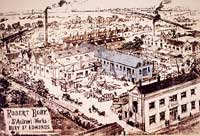
Boby's Factory |
|
1884
|
The Bury and Norwich Post reported that Robert Boby's engineering works was employing nearly 200 men in the manufacture of screening and dressing machines, hay makers and horse rakes, and most of the utensils comprising a brewers' or maltsters' plant. The St Andrews Works would also cover general engineering and foundry work of all types.
|
|
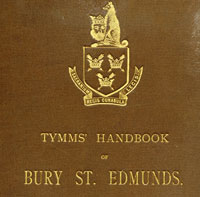
Tymms Handbook
|
|
1885
|
Not far away in Abbeygate Street, was another business which would last well into the second half of the 20th century. This was the booksellers, F T Groom. They were the publishers of the Handbook of Bury St Edmunds, written by Samuel Tymms, Honorary Secretary of the Suffolk Institute of Archaeology and Natural History. Tymms had written many learned papers on the history of Bury, and despite his death, Grooms continued to sell the latest and 5th Edition of his Handbook as Tymms' Handbook of Bury St Edmunds. They had it printed by the London firm of Spottiswoode and Co..
The Handbook referred to the town's "distinguished Grammar School, an excellent Commercial School, a High School for Girls, a Wesleyan, and several private schools."
"There are but few manufactures; the principal being that of Malt." - Maltsters Gough; Boby; and Fison each had large maltings near the Northgate Railway station.
- Messrs Greene and King had their maltings near their breweries in Westgate Street and St Mary's Square.
- Robert Boby's St Andrews Works was making its famed Self Cleaning Corn Screening and Dressing Machine, having produced over 11,000 units. It had also produced 7,000 Haymakers.
- Mr G Cornish had "another considerable iron foundry in Risbygate Street."
|
|
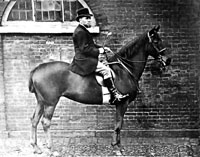
Jesse Gough c1890
|
|
blank |
The London Gazette for October 20th, 1885, contained this announcement,
"NOTICE is hereby given, that the Partnership heretofore subsisting between us the undersigned,
George Boby and Jesse Gough, carrying on business as
Maltsters, at Bury Saint Edmunds and Stowmarket, both in
the county of Suffolk, was dissolved, by mutual consent,
on and from the 30th day of September last. All the
debts due by and to the late partnership will be paid
and received at their office, Station Works, Bury St,
Edmunds.—Dated this 7th day of October, 1885.
George Boby.
Jesse Gough."
|
|
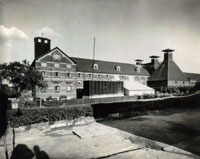
Gough's Maltings
|
|
blank |
This was the year that Jesse Gough commissioned his newly finished Maltings built on Thingoe Hill. It is likely that this replaced other buildings already on the site. He left his existing partner, George Boby, to set up on his own behalf. This malthouse would become called the Old House, when a second malthouse was built on the same site in 1890.
In 1885 Henry Stopes wrote in his book, "Malt and Malting" that "Malting is a decaying industry". Yet some of the largest maltings were yet to be built. This book was the maltsters' bible for the rest of the 19th century.
|
|
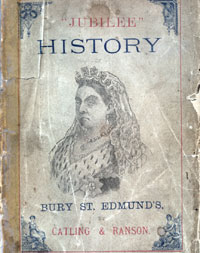
Jubilee History of Bury |
|
1887
|
In June 1887 Messrs Catling and Ranson of 8 Lower Baxter Street, Bury St Edmunds, published this "Jubilee History of Bury St Edmunds" as part of the town's Jubilee celebrations.
Greene's Westgate Brewery was given four pages to itself, as the largest brewery in the town, but King's St Edmund's Brewery was second, followed by The Saracen's head, the Golden Lion and the Risbygate Breweries. The 'History' had to add an addendum at the final page to mark the merger of Greene and King, which had been announced in May.
By 1st June 1887, Fred King and his St Edmunds Brewery of St Mary's Square, had bought up 52 tied public houses. In response, over the years since King began brewing in 1868, Edward Greene of the Westgate Brewery had felt forced to buy 91 in total and to lease others. This fierce competition had pushed up pub prices and hurt both businesses. So Mr Greene and Mr King amalgamated their breweries, and Greene King was born. Ownership was two-thirds to Greene and one-third to King. The new company now owned a total of 148 licensed premises. Not wishing to flaunt their virtual monopoly in West Suffolk, at first the merger was not advertised, the pub signs showing no owner's name.
|
|
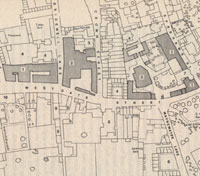
The new Greene King Brewery |
|
blank |
Details of the merger were handled by Edward Lake, the Managing Partner of Greene's brewery, and Edward Greene's trusted nephew. The company was floated as a Limited Liability business under the new Companies Act as did 29 other breweries in that year.
Despite the rise of the big brewer, beer was also still brewed at the Saracen's Head and the Golden Lion, both in Guildhall Street. Most publicans were by now taken over by one of the breweries, and so they took beer from their proprietor brewer. The Saracen's Head building was occupied for many years by the British Legion Club, but by 2012 it became the Hunter Club.
In Risbygate Street, Clarke's Brewery was also operating, having been started in 1848.
The Bristol Estate Book for 1887 recorded that however bad the farmers' position in 1884, it was worse now. Wheat had fallen to the unprecedented level of 32s a quarter, but barley, wool, meat and dairy were all making prices less than the cost of production.
|
|
1890
|
In 1890 Jesse Gough doubled the size of his maltings on Thingoe Hill by having the New House built alongside the Old House. No doubt these two names only arose after this time as a way of differentiating the buildings.
|
|
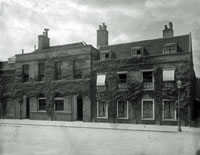
Mr Girardot's house
|
|
1891
|
Girardot and Company of Bury St Edmunds, registered themselves as Maltsters with a share capital of £50,000. From 1890 to 1906, the Girardot family lived at 113, Northgate Street, a grand house once owned by Sir Thomas Gery Cullum before 1831.
In Kellys Directory of Suffolk for 1891 T & H Wenn & Co are listed in Tayfen Road and also at Downham Market. In Kelly's Directory for 1900 the listing for Downham Market no longer exists. T H Wenn and Co are not mentioned in Pawseys 1927 or Kelly 1937, and thus appear to have been short lived.
|
|
1893
|
At Ipswich, R And W Paul set up their registered company with a share capital of £250,000.
Paul's Malt would continue to be a growing presence in the production of malt through into the 21st century.
|
|
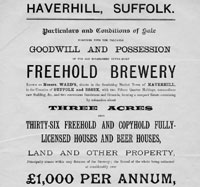
Sale of Ward's Brewery
|
|
1894
|
In January 1894 William Ward auctioned off the Haverhill Brewery with 36 pubs tied to it covering an area as wide as Castle Hedingham, Saffron Walden, Fulbourn and Swaffham Bulbeck. It had been established in the 1840s. William Ward was the owner by 1885. At this sale in 1894 the brewery was bought by Frederick Charles Christmas for £29,100, and on his death in 1918 the brewery and 49 public houses would be sold to Greene King & Sons Ltd. It occupied buildings on both sides of Camps Road and Upper Downs Slade, and the main building has become better known as a laundry in recent years.
|
|
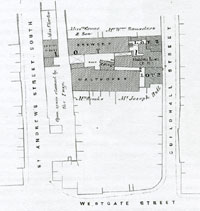
Golden Lion Brewery & Pub
|
|
1896
|
In 1896 it seems that the Golden Lion Brewery in St Andrews Street (South), ceased its brewing operation. The Golden Lion pub in Guildhall Street, (now number 57) continued to function as a pub, but it was sold to the Saracen's Head Brewery, which was still operating a few doors north on Guildhall Street.
Greene King bought out the Newmarket Brewery of Miss Moody, together with her 10 public houses, for £22,500. Greene King's Managing Director, Edward Lake, was made Mayor of Bury for the third time, having previously been mayor in 1886 and 1892.
|
|
1898
|
At Mildenhall the Maltings of the Parker Brothers was registered as a company with a share capital of £20,000.
In Bury St Edmunds and Leeds, R & G Boby and Chapman set up a registered company to trade in malt with share capital of £45,000.
In 1898 the Rating assessment of Greene King's brewery was increased by 75%. The assessment was in the hands of the Board of Poor Law Guardians, and they noted that the brewery was more than prospering, and that there had been no increase in their assessment for a decade.
The firm appealed and pleaded that the brewery was old, antiquated and too inefficient to merit such an increase! They needed 1200 tons of coal a year, which all had to be hauled the mile or so from the railway station using their own stable of 46 horses. All the hops and barley needed, and the beer produced, had to be similarly transported. The brewery won its appeal with costs, but the case showed that Greene King stuck to old methods and equipment, but were able to produce good quality beer nevertheless.
|
|
1899
|
James Fison and Sons set up a registered company at Thetford to produce malt. In 1920 the company was acquired by Edward Packard and Company and in 1944, it was taken over by Paul's Malt
In 1908 Edward Fison would similarly register a company at Ipswich for the same purpose, with capital of £30,000. In 1935 Edward Fison of Ipswich would be taken over by Muntona.
|
|
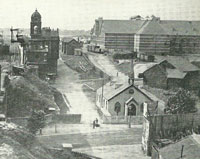
Gough's Maltings behind Railway Mission
|
|
1900
|
On 20th May, 1900 the Railway Mission was opened in Bury St Edmunds, at Fornham Road. This view of the Mission Hall also shows Gough's maltings in the background. The picture dates from 1900 to 1903 as the Mission Hall was extended from its existing five windows length in 1903.
The significance of this picture is that it shows goods waggons outside the maltings on the railway spur specifically built to serve the maltings.
In Kelly's Directory of Suffolk for 1900, the following were listed as Maltsters in Bury St Edmunds:
- Bishop and Co at 65 Guildhall Street
- Clarke Brothers, at 87 Risbygate Street
- Girardot and Co Limited at Northgate Maltings, Bury and Woodbridge and Brentwood
- Jesse Gough and Sons, Northgate St Bury; GER station Stowmarket; and Bures St Mary RSO
- Green, King and Sons, Bury ale stores, Station Rd Stowmarket & Westgate Brewery, Bury
- J Hearn and Son, Southgate Street, Bury and Beyton
- James Rolfe and sons 48 St Andrews Street South, Bury
- T H Wenn and Co, Tayfen Road, Bury
- C Wing 10 St Andrews Street North, Bury
This is a selected list of other maltsters around the area who are of interest for one reason or another. There were many others in the Directory as well as these few:
- George Abbot at Boxted
- Walter Clarke at Great Welnetham
- John Goodchild at Kedington
- George King at Hartest
- Oliver Brothers Sudbury Brewery
- Parker Brothers Lark Roller Mills, Mildenhall, Icklingham and Barton Mills
- R & W Paul Lim. Bury Street, Stowmarket, Paul's Quay Ipswich, Little Stonham. Stowmarket and Woodbridge
- Thomas Prentice Stowmarket and Ipswich
- Walter Savage, Stradishall
|
|

Jesse Gough c1890
|
|
1901
|
Jesse Gough was born on 16th June 1832 and died on 5th March 1901. He was born in Gawcott, Buckinghamshire and married his wife Elizabeth Salmon in 1855. They left for Australia in May 1855, where Jesse worked in a store and made friends with a Charles Smith. They then started up a successful maltings business in Melbourne. Returning to England in about 1870 he set up as a maltster in Out Northgate, and until 1885 had been in partnership with George Boby at Boby's Station Works.
He built the large Old House and New House maltings on Thingoe Hill, behind the Bury St Edmunds railway station, and acquired other maltings across East Anglia. While other maltsters had struggled, Gough had flourished, and upon his death his estate was valued at £150,000, a very considerable sum.
Like other prominent men he played a part in civic life. He was an Alderman, but he twice turned down the opportunity to be Mayor, giving the excuse, "that he was far too busy to take on that role!" He was a JP and worked to enable Bury St Edmunds to acquire better street lighting for the town, as he was on the Electric Supply Committee. In his Thingoe maltings he had his own electricity by means of a generator, so had this luxury before Bury had its street lighting. By the time of his death the town's electricity generating station had been completed, and he could have been alive to see the first of the electric lighting in the town.
|
|
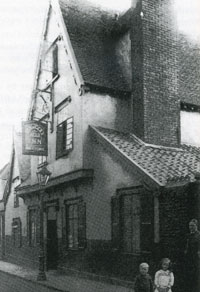
Saracens Head
|
|
blank |
At 63 to 65 Guildhall Street, the Saracens Head inn closed down, owing to the bankruptcy of Bishop's Brewery. The Great Head, as it was often known, dated back well into the 18th century and had included the Brewery for 'Bishop's noted Bury Ales'. When put up for sale, there was no bid for the Brewery, or the Saracens Head and its first tied house, the nearby Golden Lion. The other tied house was the Coach and Horses in Honey Hill, and this was withdrawn from sale at a bid of £1,800. Later the empty Saracen's Head became home to the British Legion Club.
When this inn and brewery shut down in 1901, other independent inns like the Coach and Horses in Honey Hill had to get their beer elsewhere. The Coach and Horses now bought beer from Hudson's Brewery in Cambridge. The Coach was ideally located to serve the courts, and both witnesses and barristers were often to be found there.
Hudson's brewery already had a presence in Bury. It owned the Red Lion in Ipswich Street, for example, first set up in the 1860's. It would let it to Clarke's Risbygate Street Brewery in 1905.
|
|
1902
|
In 1902 Greene King owned and leased 70 pubs and off licenses in Bury, and 180 in the Country trade roundabouts, all supplied from Bury. The company also owned 128 houses further afield which were supplied from local depots fed by railway from Bury. They had centres at Ely, Fakenham, Colchester, Haverhill and Stowmarket. The company continued to expand by acquiring new pubs, aiming at Suffolk Essex and Cambridgeshire.
|
|
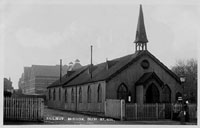
Gough's Maltings behind Railway Mission
|
|
1903
|
This shows another view of Gough's Maltings behind the tin tabernacle in the early 1900s.
In 1903 the Railway Mission was extended after only being in existence since 1900. You can date this picture to after this date because the Mission now has eight windows along its south side. The original building of 1900 only had five windows on this side.
|
|
1907
|
Pawsey's had been publishing postcards in Bury since 1903. In November 1907, F G Pawsey and Company, Limited, of 25 and 26 Hatter Street, Bury St Edmund's, printed and published their large book entitled "West Suffolk Illustrated".
The text was written by Horace Barker, and amongst other observations on Bury St Edmunds
he wrote that the the depression in agriculture had impaired the town's former prosperity. But it still had considerable corn and cattle markets. There were several large maltings, including Gough's, Girardot's, and Boby's as well as Greene King's own for its brewery.
The Golden Lion was one of the many inns which closed down in the early years of this century. It stood at 57 Guildhall Street, between today's British Legion club and Westgate Street. Like the Saracens Head it had also housed a sizeable brewery, reaching back to St Andrews Street. Some of these brewery buildings were only redeveloped into housing as late as 2004/05, but had enjoyed many other uses in between. In the late 19th century, J A Simmonds had proudly advertised his Golden Lion brewery in the 1889 Wilkin's Almanac as to the "gratifying reports from ...the public analyst at Ipswich", and that he was "Contractor to the Suffolk General Hospital."
|
|
1908
|
In Southgate Street the Southgate Brewery closed. This was, in fact, a beerhouse which prior to 1886 had called itself the Jolly Toper. As Braddock's Southgate Brewery had closed down in 1868, perhaps this brand name was seen as available. In any case the Jolly Toper had possessed its own brewery since at least 1833, and may still have been brewing in 1908. This pub is now a home, number 13 Southgate Street, and Toper Lane survived for many years as a path from the yard to Raingate Street.
|
|
1912
|
The Golden Fleece had stood on the corner of Churchgate Street and College Street since 1737, and was probably the last public house in Bury to brew its own beer. Brewing took place on two days a week right up until 1912 or 1913, when brewing on the premises ceased. The Golden Fleece itself continued as a pub until 1933. The only other Public House possibly still brewing its own beer at this time was the St Edmunds Head, in Cannon Street.
|
|
1913
|
R Peach and Company set up as a registered company at Burton upon Trent with registered share capital of £20,000.
In 1913 the leading sales-maltster by production capacity was Edward Sutcliffe of Mirfield. Second came Gilstrap Earp & co of Newark, third was R & W Paul of Ipswich. Number 7 was H A & D Taylor of Sawbridgeworth who would soon have a presence in Bury St Edmunds.
|
|
1914
|
The Great War had a profound impact upon brewers and a potentially greater impact upon Maltsters. In November 1914 beer duty was increased from 7/9 to 23/- a barrel, an increase of about 300%.
Further restrictions would follow.
|
|
1915
|
An advisory committee was established to consider the feasibility of state ownership of beer production and public houses. It would be reconstituted in 1917 and by 1918 would report that there were no barriers to nationalisation. The brewing industry and the Maltsters were under this political pressure as well as the financial pressure of taxation and restriction.
|
|
1916
|
In Kelly's Directory of Suffolk for 1916, the list of Suffolk Maltsters had shrunk since 1900. However, the following were listed as Maltsters in Bury St Edmunds:
- J Gough and Sons, Bury and Fornham All Saints
- Greene, King and Sons Ltd, Westgate Brewery & Bury ale stores, Station Road, Stowmarket
- H A & D Taylor Ltd Out Northgate
- T H Wenn and Co Tayfen Road
In December, 1916, beer production was cut under the Defence of the Realm Regulations to 70% of the level of 1913/1914.
|
|
1917
|
In March 1917, beer production would be limited by law to just 28% of pre-war levels. At these levels those breweries that survived would only require the capacity for malt that brewers were producing themselves. Sales-Maltsters would be ruined.
The malt industry response was to revive the long forgotten Maltsters Association of Great Britain, wwhich had ceased to exist when the malt tax was repealed in 1880. This gave them an official collective voice with which to approach government to plead their cause.
During April 1917 the brewery of the Clarke Brothers of Risbygate Street in Bury was taken over by Greene King's Brewery. Clarke's Risbygate Brewery had been set up in the 1840's, and by 1917 it was Greene King's only serious competitor in Bury. The old guard of the Greene King brewery Board were by now either dead or in poor health. Likely relatives had joined the army, and around 90 of the workforce had also signed up by now. Edward Lake was left to run the firm without much serious assistance. He wanted to bring in Harry Clarke to run the maltings and barley side of the business. Against some opposition from the family, he persuaded Raymond Greene, MP, to go along with him. Clarkes' were paid £29,615 in shares and stock, and Clarkes Brewery was quickly closed down.
The arrangement included Clarke's 28 public houses like the Kings Arms in Brentgovel Street, but the best inn was the Cupola House, along with its wines and spirits business, owned by Clarke's since 1901.
During the last century the Kings Arms had been another of the important carriers house, and its yard is still visible. This public house, like the Cupola, still survives in 2005.
The Plough inn in Southgate Street had been a drovers inn in the 18th century, but this was less practical during the 19th century as the street became more built up. Greene King had the Sword in Hand on the opposite side of the road and relinquished the license of the Plough.
Edward Lake continued to think about amalgamation as helping with some of the problems of war time production. By December he was engaged in talks with the last two sizeable breweries left in West Suffolk. These were Christmas's of Haverhill and Olivers of Sudbury.
Fairly soon in 1918, Christmas's Brewery plus 49 public houses was bought for £55,000 in cash and War bonds from the trustees of the late F C Christmas.
Olivers Brewery at Sudbury was run by two brothers, but only one was offered a Directorship with Greene King. This made negotiations more difficult. They were paid £69,000 in shares and cash, and the deal included another 51 public houses for the Greene King empire.
Both Christmas and Olivers Breweries were kept open, boosting Greene King's output by 37%.
|
|
1918
|
In 1918 fire destroyed one of Greene King's maltings.
At this time Greene King was operating several small individual malthouses. Braddock's old White Hart maltings was still in use. Number 1 malthouse was near the site of todays BMI hospital, located between Sparhawk Street and Southgate Street.
Others were distributed from No 3 in Sparhawk Street next to the barley stores to the Foundry Malthouse fronting Westgate Street and the adjacent Rink Maltings, on the corner of College Street. It was built in 1880 on the site of Mr Robinson's 1876 skating rink. School maltings was next to the Feoffment School.
Len Bridgeman of Nowton Road can remember his father (born in 1874) telling him of his time at the Greene King Maltings, for the first part of his working life he worked in maltings at Mistley, Sudbury and Stowmarket before joining GK as foreman of No 1 Maltings in September 1917. This particular building situated near todays BMI hospital was burnt out in 1918 after a grain dryer overheated.
|
|
1919
|
Eventually in 1919 all the restrictions upon malt production imposed during the Great War were lifted.
In July 1919 the Order allowing the use of female labour was revoked. The Maltsters Association, supported by the Brewers Society got the use of women 's labour extended to Summer, 1920. They had relied upon the women during the war and many skilled maltsters had not returned home.
In June 1919, Edward Lake resigned as Managing Director of Greene King's Brewery, in order to retire. His last report stated that the company owned 460 public houses compared to only half a dozen when he started in 1873. There were three breweries in the company, one in Bury, the old Christmas Brewery in Haverhill, and the ex-Olivers at Sudbury. It was now the largest Brewery in East Anglia.
|
|
1922
|
Despite the optimism of 1919, beer production was falling and so was the demand for malt. The price of malt was falling after 1920. Members of the Malting Association were only working at half capacity. The firm of J Gough of Bury St Edmunds resigned from the Association as it was no longer thought worth the subscription.
Many smaller maltsters suffered losses and this situation continued until 1933.
|
|
1923
|
Brewing ceased in Haverhill late in 1923 when Greene King shut down their Haverhill operations. The firm had bought Christmas's Brewery there in 1918, and kept it running. The sharp recession had led to a fall in sales of beer and the needs of Haverhill could be met by lorry from Bury. Some of the workforce moved to the Westgate Street premises of Greene King in Bury St Edmunds, travelling up to 40 miles a day.
Olivers Brewery at Sudbury was next on the list for closure by Greene King, but the 1923 budget reduced the duty on beer by 20 shillings a barrel, so there was a stay of execution.
|
|
1924
|
In 1924 Bailey and Tebbutt's Panton Brewery in Cambridge came up for sale. Despite closing their Haverhill operation in 1923, this was an opportunity for Greene King to get a foothold in Cambridge. Sales had picked up since 1923, and in February 1925, Greene King, bought this brewery with 48 public houses, for £152,000. This added a third to Greene King's capacity and turnover, most of it in the city, which avoided the worst of the agricultural depression plaguing the countryside economy.
|
|
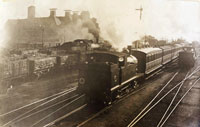 Gough's maltings by the railway
Gough's maltings by the railway
|
|
1925
|
This picture shows Gough's impressive Maltings on Thingoe Hill, behind the railway station.
In Kelly's Directory of Suffolk for 1925/26 the following were recorded as maltsters in Bury St Edmunds:
- R W Dewin and Co, Fornham All Saints and Tayfen Road, Bury
- J Gough and Sons, Thingoe Hill, Bury
- H A & D Taylor, Out Northgate, Bury and Fordham Road, Newmarket
Greene King no longer appear in this list, but continued to make malt, but possibly this omission implies that they no longer sold malt to other brewers or buyers. R W Dewin appear to have taken over the premises previously occupied by T & H Wenn.
|
|
1927
|
In Pawsey's directory for 1927, the maltings of H A & D Taylor are recorded in Out Northgate, presumably on the site just south of the railway arch where they stood until demolition in 1979. Taylors appear to have been the favoured maltsters of Truman's breweries.
|
|
1928
|
ABM, the Associated British Maltsters, were set up by an amagamation of Gilstrap Earp of Newark on Trent, Edward Sutcliffe of Mirfield, S Thompson and Sons of Smethwick, and W J Robson of Leeds. ABM would continue to acquire other maltsters in the following years.
At first, for a year or so, the new company continued to trade as Gilstrap-Earp, but the aim was to allow some rationalisation of production in the face of the increased competition brought on by the fall in consumption, and increasing losses.
|
|
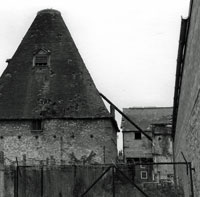 White Hart Maltings derelict
White Hart Maltings derelict
|
|
1930
|
The last vestige of the Southgate brewery which stood opposite on the corner of Maynewater Lane and Southgate Street was this distinctive malthouse. Braddock's Southgate Brewery was purchased by Edward Greene in 1868 on the death of owner, Henry Braddock. Greene demolished the brewery but kept this malthouse in use through the rear of the White Hart (now Abbey Hotel) up to the 1930s, when it was known as the White Hart Maltings.
It stood derelict for many years until in the 1980s the building was converted into two apartments.
Despite the depression, Greene King purchased Ogden's March Brewery with its 28 freehold and 6 leasehold pubs. The Brewery was shut down, allowing Greene King to take over supplies to the licensed premises around March.
Until 1930 unattended women were not allowed into pubs or restaurants at night. In 1930 the Licensing Laws were changed to put this right.
In these hard times the Government raised the Beer Duty from April 1930.
|
|
1931
|
Since 1879 there had been a prolonged agricultural depression with only a few good years from 1914 to 1921, caused by the demands of war and recovery. Not only that, but the Wall Street Crash had brought a world wide recession in its wake. Germany was particularly badly hit, with dramatic rates of inflation and unemployment. Adolf Hitler's National Socialist German Workers' Party gained support as society crumbled.
In Suffolk the price of wheat was at least half the cost of production. The result was described by Justin Brooke:- "Before 1932 thousands of acres of good farm land were left uncultivated. One could motor for miles and see field after field in an abandoned state with thorn bushes springing up where corn once grew; barns were falling down; farmhouses and cottages in a sad state."
Rayments Brewery in Furneaux Pelham had been owned since 1889 by Edward Lake and J M KIng, but all small brewers were finding life very difficult. The brewery was taken over by Greene King in 1931 solely because of the family connections.
However, throughout this time the sales of Greene King's bottled beers continued to increase.
In September 1931 the Beer Duty was increased yet again. The Maltsters Association of Great Britain declared that the malting Industry was threatened with "final and complete ruin."
|
|
1933
|
In April the budget reformed the duty payable on beer. Instead of a flat rate, the duty increased with the strength of the alcoholic content. Beer prices were cut by a penny a pint, and by June, Greene King had restored the wage cuts imposed in 1932. Production had recovered by the end of the year.
In some cases the beer duty payable was now less than in the period from 1923 to 1930.
In return the brewers were asked to use as much home grown barley as possible to help alleviate some of the distress in the farming communities. The government preferred this approach to raising tariffs on imported grain.
|
|
1934
|
In 1934 there was a gentlemen's agreement between the brewers and maltsters and the National Farmers Union to buy at least 7.5 million cwts of the domestic crop each year. From 1934 until 1939 this target was actually exceeded and some relief was gained for farmers, brewers, maltsters and consumers.
In 1934 Greene King acquired the maltings of Thomas Prentice and Company of Stowmarket.
|
|
1938
|
By 1934 most of the buildings and equipment of the brewers Greene King were up to 100 years old. The brewhouse in Westgate Street was in a dangerous state and the site was congested. St Edmunds Brewery in St Marys Square was no better. It might have been the time to consolidate and move to new premises, but in the end only the Brewhouse was attended to. So Greene King pressed on with its new brewhouse in Westgate Street, which it started in December 1936. It began production in the first days of 1939.
|
|
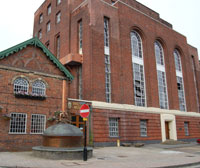 Greene King's 1939 Brewhouse
Greene King's 1939 Brewhouse
|
|
1939 |
In January 1939, Greene King's brand new Brewhouse was completed in Westgate Street on the corner of Crown Street, and brought into production. It very quickly proved itself a great success for the brewery. It had masses of spare capacity, and worked extremely well, and was airy and efficient to run. It is seen here in 2006, to the right of the 1881 building now used as a museum by the Brewery.
Inspired by this success, it was intended to move on to improve the bottling plant which was at full stretch, as well as the loading facilities which were dangerous in some cases. The Maltings also needed replacing. But it was now too late to act on any of these ideas. Decisions were put off and preparations for war stopped any chance of letting contracts.
At Greene King's Brewery Major Lake had encouraged the workforce to join the Territorial Army, particularly in the late 1930's. With the growing crisis, he found by the summer of 1939 that so many men were away at a fortnight's camp, that women were now introduced into the office for the first time.
In September, 1939, after war was declared, beer duty was immediately doubled. It would be increased throughout the war. However, unlike the situation during the Great War, there was no attempt made by government to restrict production by law.
|
|
1941
|
Civilian life in general continued to be difficult. Brewers were regarded as supporting morale in the Second World War, but they had a shortage of materials and labour to work with. Greene King estimated that 62 percent of its workforce were joined up. Of the office staff the proportion was 75 percent. Most of these 140 had joined local Territorial Units, either the 58th Medium Battery Royal Artillery, or the Suffolk Yeomanry.
These experienced workers were replaced by boys and women. The bottling plant had a completely female workforce. The brewery now made only one beer, in a light or darker version, to simplify production.
The same labour shortages affected the malting industry, and in some cases female labour was used to replace the men, as was happening in most industries.
|
|
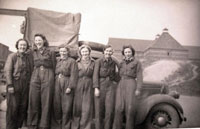 Women engineers at Mann Egertons WWII
Women engineers at Mann Egertons WWII
|
|
blank |
Like the brewery, local engineering firms also suffered from the loss of manpower into the armed forces. This picture shows women working for Mann Egerton in Fornham Road repairing tractors. Photo taken at the “Chalks” close to the railway station, with Gough’s maltings in the background.
|
|
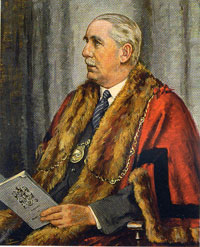
E L D Lake, "The Major"
|
|
1946
|
Major E L D Lake also died in the spring of 1946. He had been Mayor of Bury for 9 terms of office, 6 of them during the War. He had run Greene King Brewery for over 25 years, and he had brought both town and brewery through the Second World War, and his death stunned the town and the firm. Government restrictions continued, and production was curtailed until 1948.
During 1946 the large maltings behind the railway station was sold by Gough's to Peachey, but the name Gough's Maltings lingered on.
|
|
1947
|
Despite problems with production, the new managers at Greene King knew that they had finished the war with old and outdated equipment throughout the brewery, except for their magnificent brewhouse of 1939. From 1946 to 1947 the Rink Maltings on Westgate Street was fitted with four brand new Malting Drums, designed by the brewery maltster, and built by the Bury engineering firm of Robert Boby's. The old malting floor system had needed a large input of skilled men to turn the grain, and they were no longer available.
|
|
1948
|
At Greene King's Brewery, the new maltings had ample capacity for the brewery's needs. The barley store on Sparhawk Street was now inadequate. Farm mechanisation meant that the new combine harvesters could take the harvest within six weeks. Previously the delivery of barley had spread over a six month period when the stooks were slowly and laboriously threshed by steam threshing units. So the old Foundry Maltings were converted to a second grain store.
Beer duty was now at its peak and since the war ended the maltsters also suffered many restrictions and difficulties. Production of malt slowly fell to its lowest in around 1955. After 1958 conditions slowly improved for the malt and beer producers as demand increased with slowly improving prosperity.
|
|
1950
|
At Stowmarket, the malting firm of Muntons opened a new drum maltings, evidence of a new progressive attitude in the industry.
|
|
1951
|
Greene King had suffered many restrictions since 1945, both in terms of raw materials, and government regulations. It had enjoyed a boom in bottled beers, but draught beer had contracted badly. Since 1948 they had tried out some new recipes. Suffolk Ale was strong and took a long time to produce, but proved a popular buy in bottles. In 1951 they tried out a higher quality draught beer. This was called Abbot Ale and was first released in 1951. It would become one of their best known beers in the future.
|
|
1954
|
Greene King took over the Simpson's Brewery at Baldock. Its owners were threatened by the trend to amalgamation, but favoured a merger with Greene King to ensure that the Brewery stayed open. This brewery did well later in the decade because of the growth around London.
|
|
1957
|
In 1957 the Ipswich Malting Company was acquired by H A and D Taylor.
|
|
1958
|
At Sawbridgeworth the maltings of H A & D Taylor was acquired by ABM, with the rest of the Taylor Group following by 1959.
Greene King closed their Panton Brewery in Cambridge, which they had acquired in 1925.
Greene King also took over the small Sudbury Brewery of Mauldon's, with 22 public houses on the Essex border. This brewery was old, and it was agreed to close it down, and supply the pubs from Bury.
After 1958 conditions slowly improved for the malt and beer producers as demand increased with slowly improving prosperity. This also resulted in higher labour costs, which in turn encouraged the adoption of mechanisation to replace the low cost labour of the pre-war years.
|
|
1959
|
In 1959 ABM restructured into four zones. The Eastern Zone was headquartered in Bury St Edmunds covering H A & D Taylor and its subsidiaries, (the Ipswich Malting company, J W & H Branston, and W B Walmsley), John Crisp and Son, (Beccles), and T W Wilson of Hadleigh.
The brewers who were customers of the maltsters were often quite conservative and disliked the idea of dealing with a massive concern like ABM. They might insist upon malt from a specific maltings, regardless of distance. For example, the Courage Brewery at Devonport, Plymouth, took all its malt from H A & D Taylor at Bury St Edmunds.
|
|
1960
|
The Pauls Malt business was founded in Ipswich in around 1842 by Robert Paul and was incorporated as a limited company in 1893, as R & W Paul Ltd, named after the founder’s sons, Robert and William, and as a plc, Pauls, in 1960.
|
|
1961
|
Early in 1961 the Greene King brewery acquired Wells and Winch at Biggleswade. With its 287 pubs, it was the biggest acquisition ever made by the firm. The Redman family wanted this brewery to remain open, and Greene King wanted to be big enough to remain independent. This deal gave them access to Bedford, Luton, and Watford, and a total of 900 tied houses.
|
|
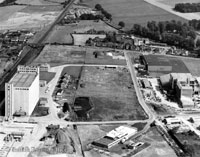
ABM new maltings
|
|
1962
|
ABM finished building their new Maltings at Eastern Way. The building of their large office block had started in 1960 with silos in 1961 and the malt dispatch block in 1964 to be finished in 1966. Full production started later that year. This aerial photograph shows the silo of Associated British Maltsters Ltd and Eastern Way industrial estate. The maltings sat conveniently on the railway line for ease of distribution.
This new plant was highly mechanised and on a large scale compared to maltings of the past. It epitomised the transformation of the malting industry from being craft-based to being high technology based This trend would continue with the eventual loss of the few remaining floor maltings. (The Peach owned Gough's Maltings on Thingoe Hill would be one of the very last to succumb.)
|
|
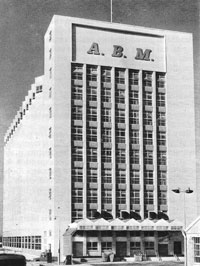 ABM Offices
ABM Offices
|
|
blank
|
Already well established by the 17th century, brewing has always been an important industry in Suffolk, with its ready supply of locally grown barley. Maltings are common in the Suffolk landscape, although by the twentieth century they were on a larger scale.
In 1968 the well known Pathe News filmed the ABM factory, and declared it the largest malting factory in Europe. This clip can be viewed on their website here: www.britishpathe.com
Pathe gives a summary of the action in the film as follows:
"Fully mechanised system in operation for drying barley at Bury St. Edmunds. Man walks between steep tanks checking gauges. CU. Barley heating and boiling. MS. Drawing off liquid. GV. Drying drums. Hand testing barley. Man at work. GV. Modern drying rooms. LV. Bagging up finished malt. GV. Large warehouse stocked with sacks of malt. LV. Large ABM lorries leaving. GV. Row of semi-detached houses, pan to ABM factory on the other side of the road."
|
|
1963
|
The malting firm of Pauls continued to expand including, in 1963, a merger with London-based White, Tomkins & Courage to create a new holding company, Pauls & White.
|
|
 Railway goods received 1970
Railway goods received 1970
|
|
1970
|
Although in decline by 1970 the railways were still a major influence on Bury St Edmunds and area life. As well as the passenger services the station handled 57,297 outgoing and 162,175 incoming parcels, 90,420 tons of incoming goods and 59,966 tonnes of outgoing goods. The area of operations from Bury for its delivery and collection fleet of vehicles extended from East Harling to Brandon in the north and from Haverhill to Sudbury in the south. The old stables building to the north of Platform 2 was used to maintain the road vehicle fleet.
|
|
 Railway goods dispatched 1970
Railway goods dispatched 1970
|
|
blank
|
A breakdown of goods received and dispatched are in the charts shown here. Thurston goods were trip worked to and from Bury by the local shunting engine. Goods from Kennett were handled by the weekdays Cambridge to Bury goods train service.
Greene King, the Bury Brewers firm, employed a firm of London Marketing Consultants to devise a proper coordinated marketing strategy for the firm. For the first time they were faced with their odd-man-out position in the modern brewing world by consultants. They gave away as much in donations and charitable subscriptions as they spent on advertising at this time. Many of their established ideas were challenged. This was the beginning of the company's rise from successful local brewer to being a national player, which it would be by the end of the century. By 1972 they began advertising on Anglia Television, which mirrored its own distribution network.
|
|
1971
|
Bury's engineering heritage took a severe blow in 1971 when the Robert Boby works in St Andrews Street was closed down. It had been owned by Vickers since 1927, and was still the biggest factory in Bury. Some 270 men were put out of work, but many Bury people still remember friends or relatives who worked there.
|
|
1972
|
ABM, the mighty Associated British Maltsters, was taken over by Dalgety.
|
|
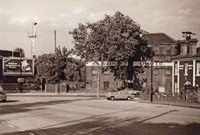
H A & D Taylors' Northgate Maltings
|
|
1973
|
H A & D Taylor's Out Northgate Maltings ceased trading during 1973. Malting had been an industrial mainstay of Bury St Edmunds for two centuries. In 1844 there were 12 separate maltsters recorded in the town. They all used the traditional malting method of spreading dampened barley on to a malting floor and employed teams of men to turn the barley over regularly until it had just sprouted. Time, temperature and humidity were vital ingredients of the task. However, like many trades, the technology of the task changed, so that modern malting involved an enclosed revolving drum; a process needing much less space and far fewer employees. In addition maltsters tended to amalgamate to obtain economies of scale, and brewers like Greene King gradually developed their own maltings.
|
|
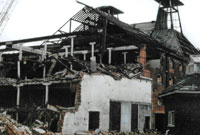
Taylors' Maltings demolished
|
|
1979
|
The maltings premises of H A & D Taylor had been up for sale via H C Wolton since 1973, but there were no viable takers. The maltings was demolished by 1979 for redevelopment.
A branch of Kettering Tyres was then built on the site. A national company, HiQ garage is here now, retaining the link to vehicle tyres.
|
|
1985
|
In 1985 the group of Pauls and White was acquired by Harrisons & Crosfield (later known as Elementis) of which George Paul, a fifth generation member of the founding family, became chief executive.
|
|
1987
|
On 1st July, 1987 Paul's bought ABM from Dalgety. This was the most important development in the British malting industry to date. Dalgety took its £31 million price tag in order to concentrate on food processing and distribution.
Paul's was already the second largest UK sales maltster, and now became the largest European malting company with a capacity of 400,000 tonnes a year.
For Bury St Edmunds it was also significant as it became the headquarters of this massive organisation.
|
|
1993
|
In Bury St Edmunds the large maltings just north of the railway station closed down. By the 1960s this had developed into the largest operating traditional floor maltings in the UK, built by J Gough and Sons Ltd. In about 1936 Gough's maltings had been acquired by R Peach and company, but the name Gough's Maltings lingered on. By 1993 this method of floor malting was uncompetitive and totally non-viable and Gough's Maltings were closed down, and demolished in 1994 to 1995.
Peach Malt, founded in the 1880s at Burton-upon-Trent, now ceased trading. Lorries with their enigmatic slogan, "Peach for Malt" would no longer be seen on Bury St Edmunds roads.
|
|
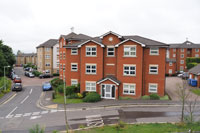
Maltings Way housing complex replaces Gough's
|
|
1995
|
In 1994 and 1995 Gough's Maltings were demolished. Eventually a large housing complex would be built on the site. Names like Maltings Way would be reminders of its former life. Only two of the maltings cottages survive the change.
|
|
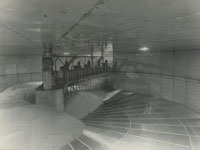
Paul's germination vessel for 340 tonnes a batch
|
|
1998
|
Greene King ceased its bottling operations in Bury. Its maltings in Westgate Street would also soon be shut down as, in February, 1998, Pauls Malt opened a new £27.7 million malting complex in Eastern Way overlooking the A14. This development was an expansion of its existing works built by ABM at Eastern Way.
This gave the Bury St Edmunds complex an additional annual capacity of 100,000 tonnes, bringing it up to 160,000 tonnes, the largest single site in Europe.
In April 1998, as part of a move by Harrisons and Crossfield to focus on its core chemicals business, Pauls was sold to the Irish-based agricultural group Greencore. Harrisons and Crossfield renamed themselves Elementis. (Greencore, as part of plans to focus on convenience foods, would sell its malt business to the French co-operative Axereal, parent group of Boortmalt, in 2010.)
|
|
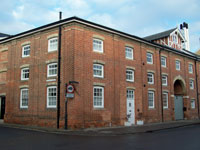
Westgate Street Housing 2004
|
|
1999
|
In 1854/5 Edward Greene built the Foundry Maltings fronting Westgate Street. In 1948 the Foundry maltings was converted to a barley store.
In 1880 he built the Rink Maltings on the corner with College Street which was converted to a drum maltings in 1946/7.
The School Maltings also adjacent, fronting Bridewell Lane, dated to 1845.
In 1999 Greene King shut down its in-house malting operation in Westgate Street. By 2004 the whole of this site would be redeveloped as luxury dwellings.
|
|
2000
|
Meanwhile, Greene King continued to expand. In 2000 the firm acquired Morlands Brewery in Abingdon, also acquiring the rights to make Morlands well respected beer called "Old Speckled Hen". This brew would become a major feature in Greene King's portfolio of beers, selling well as a bottled beer, as well as from the barrel.
|
|
2005
|
The Bury St Edmunds brewer, Greene King, continued its relentless expansion when it acquired the 71 pubs and brewery business of T D Ridley and sons of Hartford End, near Chelmsford. The brewery at Hartford End was closed down and brewing its beers moved to Bury.
|
|
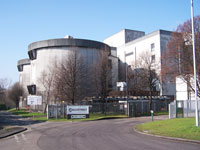
Boortmalt Eastern Way
|
|
2010
|
In February, 2010, Pauls Malt became part of Boortmalt, soon to be the largest producer of malt in the world.
Pauls had closed down some small old maltings and by 2010 operated four large maltings, one in Bury St Edmunds, one in Knapton, North Yorkshire and two in Scotland. The business was founded in Ipswich by Robert Paul in around 1842 and is now owned by the French co-operative Axereal, the parent company of Boortmalt.
The two Paul maltings in Scotland – Hillside, near Montrose, Angus, and Buckie, in Banffshire – principally serve the Scotch whisky industry.
|
|
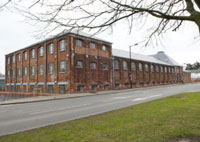
Havebury Maltings flats
|
|
2013
|
The old maltings in Mildenhall Road, Bury St Edmunds, began receiving tenants in May, 2013, following a £4m conversion to become 35 homes for Havebury Housing Partnership. The development attracted grant funding from the Homes and Communities agency of £985,000.
The mid-19th century Grade II listed Maltings had been empty since 1995 when it was last used as a furniture retail warehouse.
|
Originally prepared for this St Edmundsbury Chronicle website
by David Addy, June 18th 2020
RESOURCES USED
"The British Malting Industry Since 1830", by Christine Clarke, 1998
I am grateful to descendants and relatives of Jesse Gough for supplying some of the photographs and details used in this website.
Various extracts from the Bury Free Press and East Anglian Daily Times, where shown.
Author's collection of postcards
"Medieval Suffolk" by Mark Bailey, 2007
|


